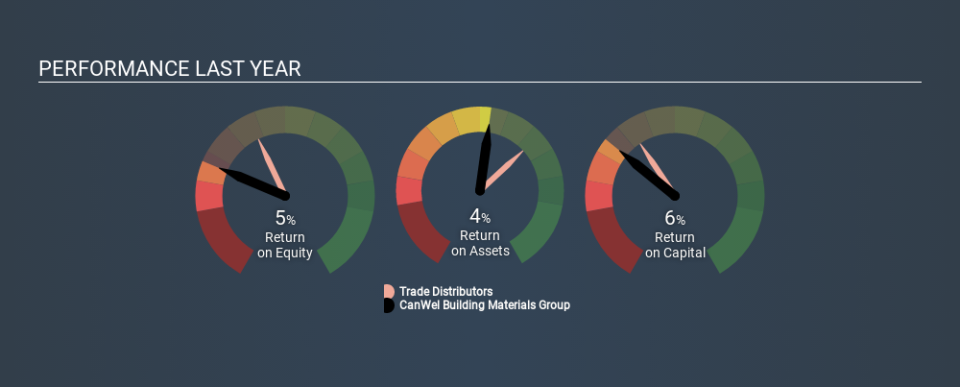Why CanWel Building Materials Group Ltd.’s (TSE:CWX) Return On Capital Employed Might Be A Concern

Today we are going to look at CanWel Building Materials Group Ltd. (TSE:CWX) to see whether it might be an attractive investment prospect. Specifically, we're going to calculate its Return On Capital Employed (ROCE), in the hopes of getting some insight into the business.
First of all, we'll work out how to calculate ROCE. Then we'll compare its ROCE to similar companies. Then we'll determine how its current liabilities are affecting its ROCE.
Return On Capital Employed (ROCE): What is it?
ROCE measures the 'return' (pre-tax profit) a company generates from capital employed in its business. Generally speaking a higher ROCE is better. Overall, it is a valuable metric that has its flaws. Renowned investment researcher Michael Mauboussin has suggested that a high ROCE can indicate that 'one dollar invested in the company generates value of more than one dollar'.
How Do You Calculate Return On Capital Employed?
The formula for calculating the return on capital employed is:
Return on Capital Employed = Earnings Before Interest and Tax (EBIT) ÷ (Total Assets - Current Liabilities)
Or for CanWel Building Materials Group:
0.059 = CA$44m ÷ (CA$894m - CA$144m) (Based on the trailing twelve months to December 2019.)
So, CanWel Building Materials Group has an ROCE of 5.9%.
See our latest analysis for CanWel Building Materials Group
Does CanWel Building Materials Group Have A Good ROCE?
When making comparisons between similar businesses, investors may find ROCE useful. Using our data, CanWel Building Materials Group's ROCE appears to be significantly below the 12% average in the Trade Distributors industry. This performance is not ideal, as it suggests the company may not be deploying its capital as effectively as some competitors. Aside from the industry comparison, CanWel Building Materials Group's ROCE is mediocre in absolute terms, considering the risk of investing in stocks versus the safety of a bank account. Investors may wish to consider higher-performing investments.
CanWel Building Materials Group's current ROCE of 5.9% is lower than 3 years ago, when the company reported a 8.0% ROCE. Therefore we wonder if the company is facing new headwinds. You can click on the image below to see (in greater detail) how CanWel Building Materials Group's past growth compares to other companies.
Remember that this metric is backwards looking - it shows what has happened in the past, and does not accurately predict the future. Companies in cyclical industries can be difficult to understand using ROCE, as returns typically look high during boom times, and low during busts. ROCE is only a point-in-time measure. What happens in the future is pretty important for investors, so we have prepared a free report on analyst forecasts for CanWel Building Materials Group.
How CanWel Building Materials Group's Current Liabilities Impact Its ROCE
Current liabilities include invoices, such as supplier payments, short-term debt, or a tax bill, that need to be paid within 12 months. Due to the way the ROCE equation works, having large bills due in the near term can make it look as though a company has less capital employed, and thus a higher ROCE than usual. To check the impact of this, we calculate if a company has high current liabilities relative to its total assets.
CanWel Building Materials Group has current liabilities of CA$144m and total assets of CA$894m. Therefore its current liabilities are equivalent to approximately 16% of its total assets. This is a modest level of current liabilities, which would only have a small effect on ROCE.
The Bottom Line On CanWel Building Materials Group's ROCE
With that in mind, we're not overly impressed with CanWel Building Materials Group's ROCE, so it may not be the most appealing prospect. Of course, you might also be able to find a better stock than CanWel Building Materials Group. So you may wish to see this free collection of other companies that have grown earnings strongly.
CanWel Building Materials Group is not the only stock that insiders are buying. For those who like to find winning investments this free list of growing companies with recent insider purchasing, could be just the ticket.
If you spot an error that warrants correction, please contact the editor at editorial-team@simplywallst.com. This article by Simply Wall St is general in nature. It does not constitute a recommendation to buy or sell any stock, and does not take account of your objectives, or your financial situation. Simply Wall St has no position in the stocks mentioned.
We aim to bring you long-term focused research analysis driven by fundamental data. Note that our analysis may not factor in the latest price-sensitive company announcements or qualitative material. Thank you for reading.

 Yahoo Finance
Yahoo Finance 
